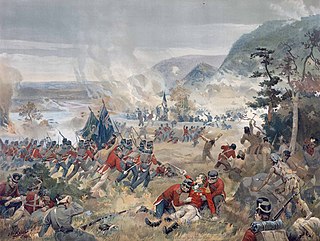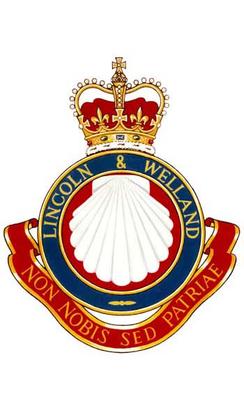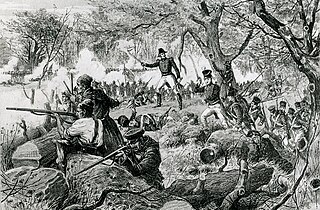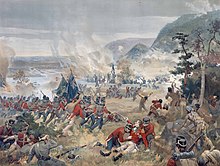The colonial militias in Canada were made up of various militias prior to Confederation in 1867. During the period of New France and Acadia, Newfoundland Colony, and Nova Scotia (1605–1763), these militias were made up of Canadiens, First Nations, British and Acadians. Traditionally, the Canadian Militia was the name used for the local sedentary militia regiments throughout the Canadas.

The Battle of Queenston Heights was the first major battle in the War of 1812. Resulting in a British victory, it took place on 13 October 1812 near Queenston, Upper Canada.
The Battle of York was a War of 1812 battle fought in York, Upper Canada on April 27, 1813. An American force supported by a naval flotilla landed on the lakeshore to the west and advanced against the town, which was defended by an outnumbered force of regulars, militia and Ojibwe natives under the overall command of Major General Roger Hale Sheaffe, the Lieutenant Governor of Upper Canada.

The Battle of Lundy's Lane, also known as the Battle of Niagara, was a battle fought on 25 July 1814, during the War of 1812, between an invading American army and a British and Canadian army near present-day Niagara Falls, Ontario. It was one of the bloodiest battles of the war, and one of the deadliest battles ever fought in Canada, with approximately 1,720 casualties including 258 killed.

The Governor General's Horse Guards is an armoured reconnaissance regiment in the Primary Reserve of the Canadian Army. The regiment is part of 4th Canadian Division's 32 Canadian Brigade Group and is based in Toronto, Ontario. It is the most senior reserve regiment in Canada, and the only household cavalry regiment of Canada's three household units.

The Royal Canadian Regiment (RCR) is an infantry regiment of the Canadian Army. The regiment consists of four battalions, three in the Regular Force and one in the primary reserve. The RCR is ranked 1st in the order of precedence amongst Canadian Army infantry regiments, but in a quirk of the rules of seniority, its 4th battalion is 9th.

The Battle of Beaver Dams took place on 24 June 1813, during the War of 1812. A column of troops from the United States Army marched from Fort George and attempted to surprise a British outpost at Beaver Dams, billeting themselves overnight in the village of Queenston, Ontario. Laura Secord, a resident of Queenston, had earlier learned of the American plans and had struck out on a long and difficult trek to warn the British at Decou's stone house near present-day Brock University. When the Americans resumed their march, they were ambushed by Kahnawake and other native warriors and eventually surrendered to a small British detachment led by Lieutenant James FitzGibbon. About 500 U.S. troops, including their wounded commander, were taken prisoner.

The Royal Hamilton Light Infantry (RHLI) is a Primary Reserve infantry regiment of the Canadian Army, based at John Weir Foote VC Armoury in Hamilton, Ontario. The RHLI is part of 31 Canadian Brigade Group, which is part of 4th Canadian Division.

The Battle of Fort George was a battle fought during the War of 1812, in which the Americans defeated a British force and captured the Fort George in Upper Canada. The troops of the United States Army and vessels of the United States Navy cooperated in a very successful amphibious assault, although most of the opposing British force escaped encirclement.

The Lincoln and Welland Regiment is a Primary Reserve infantry regiment of the Canadian Army based in St. Catharines and Welland, Ontario.

Stormont, Dundas and Glengarry Highlanders is a Primary Reserve infantry regiment of the Canadian Army. It is part of 33 Canadian Brigade Group, 4th Canadian Division and is headquartered in Cornwall, Ontario.

The Capture of Fort Niagara took place late in 1813, during the War of 1812 between the United Kingdom and the United States. The American garrison was taken by surprise, and the fort was captured in a night assault by a select force of British regular infantry.

When the United States and the United Kingdom went to war against each other in 1812, the major land theatres of war were Upper Canada, Michigan Territory, Lower Canada and the Maritime Provinces of Nova Scotia, New Brunswick, Prince Edward Island and Cape Breton . Each of the separate British administrations formed regular and fencible units, and both full-time and part-time militia units, many of which played a major part in the fighting over the two and a half years of the war.

The Queen's York Rangers (RCAC) is a Canadian Army Primary Reserve Royal Canadian Armoured Corps regiment based in Toronto and Aurora. The regiment is part of 4th Canadian Division's 32 Canadian Brigade Group. The regiment consists of one cavalry squadron, and the Headquarters and Training Squadron. The regimental family also includes The Queen's York Rangers Band (volunteer) along with two Royal Canadian Army Cadet corps and a Royal Canadian Air Cadet squadron. The unit mottos are pristinae virtutis memor – "remembering their glories in former days" – and celer et audax – "swift and bold." Among its own members and those of other regiments, the unit is referred to as the Rangers. The name is abbreviated as QY Rang, and sometimes pronounced KWY-rang.

The 2nd Regiment of York Militia was a Canadian Militia regiment active during the War of 1812. They were part of the York Militia, which at that time was three Regiments strong. The 2nd Regiment was recruited around the present-day Halton and Peel Regions.
Captain Runchey's Company of Coloured Men was a Canadian militia company of free blacks and indentured black servants, raised in Upper Canada as a small Black corps under a white officer, Robert Reuben Runchey (1759–1819), a tavern keeper from Jordan, Upper Canada. The unit fought in several actions during the early part of the Anglo-American War of 1812. In 1813, Runchey's Company was converted into a unit of the Canadian Corps of Provincial Artificers, attached to the Royal Sappers and Miners, in which sappers and miners performed specialized military operations. They served on the Niagara River front during the war, and were disbanded a few months after the war ended. The Company of Coloured Men's military heritage is perpetuated in the modern Canadian Army by the Lincoln and Welland Regiment.
Twenty-three currently active battalions of the Regular Army earned credit for campaigns during the War of 1812: two Air Defense Artillery battalions, six Field Artillery Battalions and seventeen Infantry battalions. These twenty-three battalions represent two Air Defense Artillery, four Field Artillery and seven Infantry regiments. Three additional Air Defense Artillery regiments have been awarded shared credit for War of 1812 campaigns, but the lineages of the artillery companies that earned those credits have not been perpetuated by currently active battalions.
The 1st Battalion, Canadian Mounted Rifles, CEF, was an infantry battalion of the Canadian Army. Raised for service during the First World War as part of the Canadian Expeditionary Force (CEF), it was formed in November 1914, in Brandon, Manitoba. Originally a mounted infantry unit named the 1st Regiment, Canadian Mounted Rifles, CEF, which was expanded, following its rerolling and dismounting as an infantry unit, by absorbing other units of the Canadian Mounted Rifles (CMR).
Captain Robert Reuben Runchey was a Canadian tavern owner who served as the first commander of Captain Runchey's Company of Coloured Men in Upper Canada during the War of 1812. Runchey was an officer in the 1st Lincoln Militia when Major-General Sir Isaac Brock appointed him commander of the all-black Company. He served from the summer of 1812 when the Company was created until the fall of that same year.
The 2nd Dragoons was a cavalry regiment of the Non-Permanent Active Militia of the Canadian Militia. In 1936, the regiment was Amalgamated with the 10th Brant Dragoons to form the 2nd/10th Dragoons – today now part of the 57th Field Artillery Regiment, RCA.












